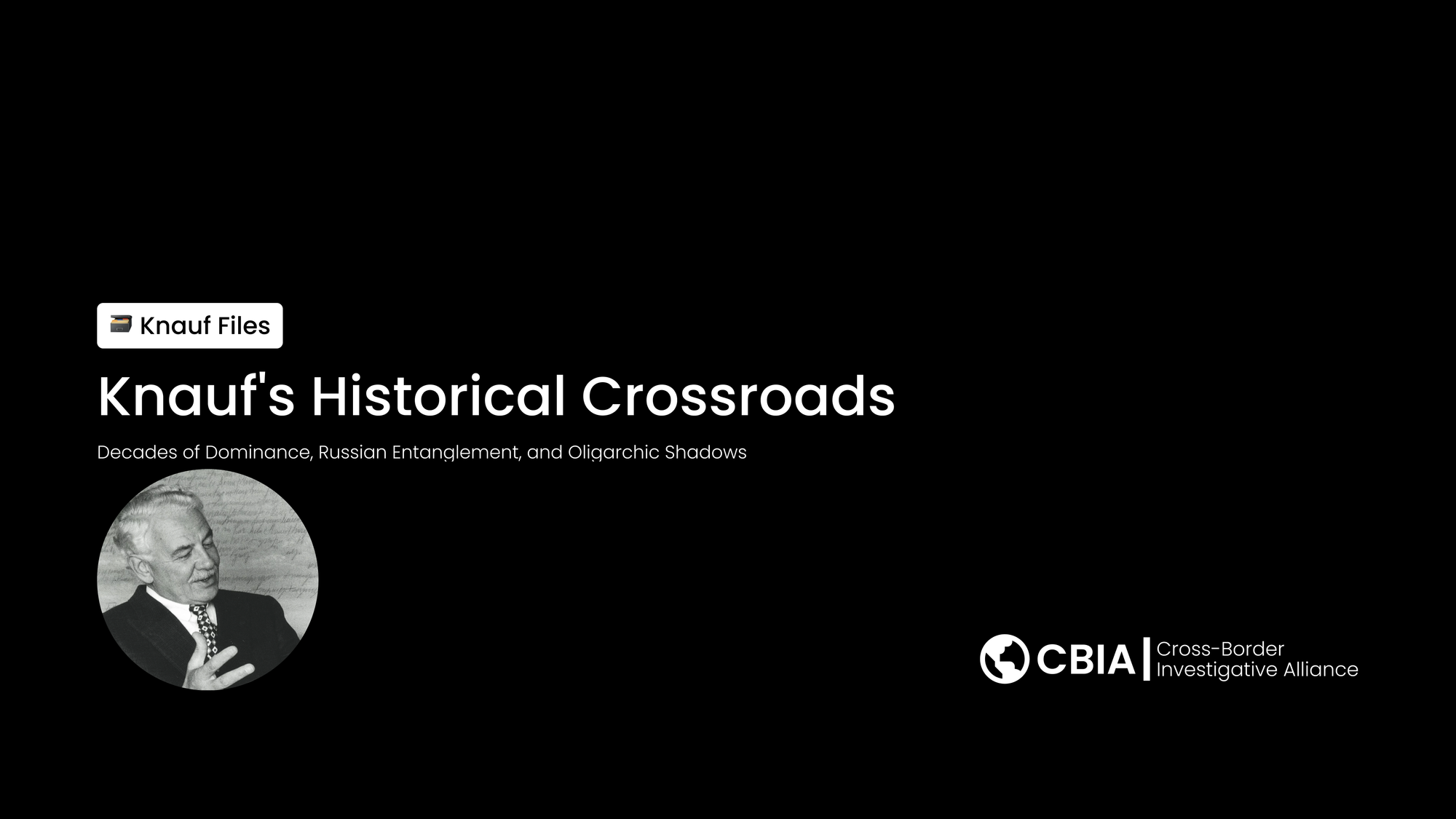Knauf's Historical Crossroads

Decades of Dominance, Russian Entanglement, and Oligarchic Shadows
The Knauf Group, a titan in the global building materials industry, has meticulously crafted a narrative of quiet ambition and strategic growth since its inception in 1932. From its origins in Germany, the family-owned enterprise expanded across continents, becoming synonymous with drywall systems, plasters, and a diverse range of construction solutions. However, a deeper look into its historical trajectory, particularly its deep and prolonged engagement with Russia, reveals a complex web that has now ensnared the company in a controversial entanglement with Kremlin-linked oligarchs. This investigative piece explores the historical decisions and relationships that paved the way for Knauf’s current predicament, where its past success in Russia casts a long, unsettling shadow over its global reputation.
The Genesis of a Giant: From Gypsum Quarry to Global Vision (1930s - 1970s)
The foundation of Knauf was laid in 1932 by two mining engineer brothers, Alfons and Karl Knauf. Their visionary acquisition of mining rights to a gypsum quarry in Schengen, Germany, marked the start of an industrial empire. The very next year, in 1933, Knauf's first gypsum factory was established in Perl, Moselle, setting the stage for what would become a global leader in gypsum-based products. This early focus on gypsum, a material with inherent properties for heat resistance and insulation, reflected the founders' foresight into its untapped potential in building construction.
The post-World War II era provided a crucial impetus for Knauf's growth. With Germany undergoing massive reconstruction, the demand for efficient and reliable building materials soared. In 1949, the company strategically relocated its headquarters to Iphofen, Bavaria, positioning itself at the heart of the rebuilding effort. A pivotal milestone arrived in 1958 with the industrial production of gypsum plasterboard. This innovation was revolutionary, offering a faster, more flexible, and cost-effective method of interior construction compared to traditional wet plastering. This development didn't just expand Knauf’s product line; it fundamentally altered construction practices, establishing Knauf as a pioneer in drylining systems. The company continued to innovate, introducing the world's first machine-applied plaster, "MP75," in the mid-1960s, along with the necessary mixing and conveying machinery and modern flowing screeds based on anhydrite. These advancements solidified Knauf’s reputation for technical leadership and efficiency.
The 1970s marked a deliberate diversification beyond the core gypsum business. Knauf made its first significant investment outside gypsum in 1970 by acquiring a stake in Deutsche Perlite GmbH, venturing into new material sciences. This was followed by the expansion into construction chemicals, lime- and cement-bound plasters, and mineral ceiling systems, showcasing a strategic intent to offer comprehensive building solutions. A landmark move occurred in 1978 when Knauf embarked on its global expansion, establishing its insulation materials division by acquiring a glass wool insulation facility in Shelbyville, Indiana, USA. This acquisition laid the groundwork for Knauf Insulation, a subsidiary that would independently grow into a formidable global player.
The Second Generation and Accelerated Global Expansion (1980s - 2010s)
The early 1980s saw the ascension of the second generation of leadership, Nikolaus and Baldwin Knauf, sons of the founders. Under their guidance, Knauf’s global footprint accelerated dramatically. Their consistent adherence to the family's core corporate philosophy – described as "Menschlichkeit" (humanity/humanism), Partnership, Commitment, and Entrepreneurship, guided an aggressive internationalization strategy. Knauf began establishing manufacturing operations across an ever-growing list of countries, including Turkey, the CIS (Commonwealth of Independent States) region, China, South America, North Africa, Central & Eastern Europe, Australia, and Southeast Asia.
Strategic acquisitions continued to fuel this expansion. Knauf Insulation, in particular, solidified its global presence by acquiring the European activities of Owens Corning in the early 2000s. Further significant acquisitions included Vunizol, a Rock Mineral Wool factory in Serbia (2005), and Heraklith (2006), a major manufacturer of Rock Mineral Wool and Wood Wool, which significantly bolstered Knauf’s market position in Central and Eastern Europe. These moves enabled Knauf to offer a broader spectrum of insulation solutions and leverage greater economies of scale.
Beyond insulation, Knauf’s portfolio continued to diversify. The formation of Knauf Industries, a division specializing in molded parts from cellular resins (like EPS and PPE) and plastic injection/extrusion-thermoforming, demonstrated a strategic leap beyond traditional construction materials into sectors like automotive, food, and healthcare. This historical diversification showcased Knauf’s agility and foresight in anticipating broader industrial needs. In 2019, Knauf made a monumental move with the acquisition of USG Corporation's conventional gypsum business, dramatically solidifying its leadership in the North American drywall market. This was followed by the integration of USG Boral in the Asia-Pacific region in 2021 and an increased ownership in the Japanese drywall manufacturer Chiyoda Ute to 75% in 2022, underscoring a continuous strategy of consolidating market share in key global regions.
The Russian Embrace: A Deep, Costly Historical Enmeshment
Knauf's historical engagement with Russia stands out as particularly deep and, ultimately, controversial. The company first entered the Russian market in the early 1990s, capitalizing on the nascent opportunities presented by the post-Soviet economic transition. This was not a tentative entry but a full-fledged commitment. By 1993, Knauf had initiated the acquisition and modernization of numerous industrial sites across Russia, investing over €1.65 billion in the Russian economy since that time. This aggressive expansion quickly led to Knauf establishing 10 subsidiaries, 20 production plants, and employing some 4,000 individuals across the vast country, making it, by 2023, the largest German investor in the Russian construction industry.
A central figure in this deep historical integration was Nikolaus Wilhelm Knauf, a co-owner and former CEO of the group. His unique position as the Honorary Consul of the Russian Federation from February 1999 to March 2022 (a remarkable 23-year tenure) provided an unparalleled channel of communication and influence with the Russian political establishment. Operating a representative office in Nuremberg with consular powers, Nikolaus Knauf's role transcended mere business; it was a symbol of deep diplomatic-business ties between Knauf and the Kremlin. His presence in official photographs with President Vladimir Putin as early as 2010 further underscored the high-level nature of this relationship. This historical proximity became even more pronounced when, following Russia's annexation of Crimea in 2014, Nikolaus Knauf publicly criticized Western sanctions, advocating for continued business engagement with Russia despite the geopolitical tensions. This stance, while perhaps rooted in protecting Knauf's extensive investments, signaled a corporate willingness to navigate, and seemingly accept, the evolving political landscape in Russia.
Knauf's historical strategy in Russia was predicated on comprehensive localization: "to produce from local materials, with local staff and for the local market (by German standards)." This approach led to a near-total incorporation of Knauf's operations into Russia's economic fabric, fostering strong relationships with local authorities and, by extension, elements of the Russian state apparatus. This historical pathway, while fostering immense growth and profitability for decades, would ultimately lead to its current predicament.
The Oligarchic Shadow: A Modern Consequence of Historical Ties
The historical groundwork laid by Knauf in Russia has reached a critical, and controversial, juncture in the wake of Russia's full-scale invasion of Ukraine in February 2022. Knauf’s initial decision to maintain its significant Russian operations, despite widespread corporate exits, drew intense international scrutiny. Citing responsibility for its 4,000 employees and its long-standing customer relationships, the company initially resisted calls for withdrawal. This historical commitment was viewed by critics as implicit support for the Russian economy.
The most severe blow to Knauf's reputation came with its designation by Ukraine’s National Agency on Corruption Prevention (NACP) as an "international sponsor of war" in December 2023. The NACP’s rationale was clear: Knauf’s substantial tax payments to the Russian state budget (estimated at $117 million in 2022 alone) directly contributed to funding Russia’s military aggression. Furthermore, investigative reports from German media, including "Der Spiegel" and ARD's "Monitor," presented highly damaging allegations. These reports cited photographic evidence and procurement documents from Russia’s state database suggesting Knauf products were being used in the reconstruction of occupied Mariupol, a city devastated by Russian forces. Even more gravely, they alleged that Knauf materials were supplied for the modernization of highly sensitive Russian nuclear facilities, including infrastructure around intercontinental ballistic missile (ICBM) silos. Knauf has consistently denied these allegations, asserting its products are for civilian use and that it complies with all sanctions, but the historical depth of its Russian integration made such claims difficult to dismiss outright. Reports from October 2022 of Russian managers at Knauf plants allegedly collaborating with authorities on mobilization lists for employees further darkened the narrative.
The historical path Knauf forged in Russia has now, in its attempted exit, directly intersected with the very oligarchic structures it implicitly operated within. While Knauf publicly announced its intention to divest its Russian business in April 2024, the process has become fraught with complications and ethical dilemmas. Recent reports from March 2025 by German business publication "WirtschaftsWoche" (WiWo) reveal that the potential buyers for Knauf's valuable Russian assets are none other than Boris and Arkady Rotenberg. These brothers are long-standing, close associates and childhood friends of Vladimir Putin, accumulating vast wealth through lucrative state contracts, including major infrastructure projects like the Nord Stream gas pipeline and the bridge connecting Russia with annexed Crimea. Both brothers have been under extensive sanctions by the U.S., EU, and UK since 2014, precisely due to their proximity to the Kremlin.
Crucially, the WiWo report indicates that the Rotenberg brothers are not negotiating directly, but rather through Gazprombank, a state-owned Russian financial institution that is also under severe Western sanctions. Gazprombank has been explicitly identified by the U.S. Treasury Department as a conduit for the Russian government to fund its war efforts, including the purchase of military materiel and payment to soldiers.
A transaction involving sanctioned oligarchs like the Rotenbergs, and facilitated by a sanctioned entity like Gazprombank, presents immense legal and reputational risks for Knauf. For a company with substantial and vital operations in the U.S. market, bolstered by its significant acquisition of USG Corp., such a sale could trigger severe penalties from the U.S. Office of Foreign Assets Control (OFAC). OFAC has historically demonstrated a willingness to sanction entities involved in illicit transactions with designated persons, with implications ranging from hefty fines to being cut off from the U.S. financial system. This creates a critical dilemma for Knauf: how to exit Russia without exacerbating its own exposure to Western sanctions.
Reports suggest an internal divergence within the Knauf family and its management regarding the Russian exit. While some, potentially including Nikolaus Knauf himself given his historical views, may have initially considered options that would allow a future return or partial control, the escalating sanctions risks, particularly those impacting Knauf’s core international business, appear to have pushed for a complete and verifiable divestment. However, achieving such a "clean break" in Russia's current economic and political climate, where state-linked entities and oligarchs dominate, is proving to be a historical challenge of unprecedented scale.
Knauf's historical trajectory, from its visionary founders to its aggressive global expansion and deep entanglement in Russia, encapsulates the complexities of international business in a rapidly changing geopolitical landscape. The historical choices that propelled its growth have now led it to a critical juncture, where its legacy is intertwined with a controversial exit from Russia, directly linking it to the very oligarchic structures that underpin the Kremlin's power. The resolution of this historical challenge will undoubtedly shape Knauf’s future, serving as a stark case study of the profound and often unforeseen consequences of long-term international corporate engagement.
Sources
About us - history, values, solutions - Knauf Industries Automotive
Learn Who and What is the Knauf Group





